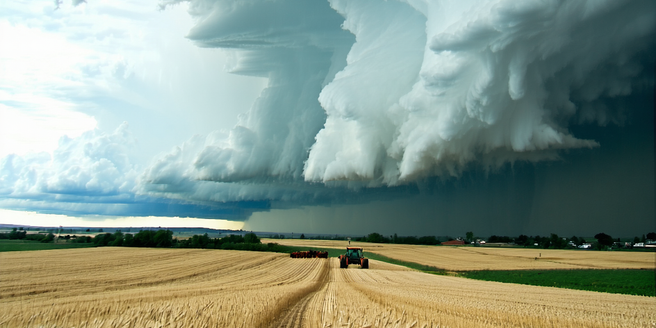
Understanding Cold Fronts: Weather Changes and Impacts
Cold fronts are significant meteorological phenomena marked by the boundary of an advancing cold air mass displacing a warmer air mass. This encounter leads to noticeable weather changes, including temperature drops, wind shifts, and precipitation. As a cold front passes through an area, the associated lifting of warm air results in cloud formation, often bringing about rain or thunderstorms. These abrupt weather shifts influence local climates and can impact daily activities. Farmers, sailors, and individuals in outdoor professions closely monitor these shifts to adapt their schedules and operations accordingly. Additionally, cold fronts contribute to seasonal transitions and are more prevalent in the mid-latitudes, particularly during autumn and spring. Recognizing and understanding these changes empower communities to better prepare for the associated impacts on weather conditions and activities.
How Cold Fronts Trigger Allergic Reactions
Cold fronts can exacerbate allergic reactions in susceptible individuals. The abrupt shift in temperature and humidity levels can cause an increase in airborne allergens such as mold spores and pollen. As cold air masses replace warmer ones, the atmospheric changes can provoke the release of these particulates into the air, causing allergic flare-ups. These reactions can manifest as sneezing, runny nose, and itchy eyes, affecting daily comfort and activities. The wind associated with cold fronts can also disperse allergens over long distances, increasing their presence in the local environment. For those with pre-existing allergies or respiratory issues, these conditions pose significant challenges. Being aware of the impact of cold fronts on allergy triggers allows individuals to take proactive measures to mitigate symptoms and maintain a better quality of life.
Common Allergy Symptoms During Cold Fronts
Cold fronts can amplify common allergy symptoms due to changes in atmospheric conditions. When a cold front moves in, allergen levels in the air, such as pollen, mold, and dust mites, may increase or become more dispersed. Individuals may experience heightened symptoms like sneezing, nasal congestion, runny nose, itchy or watery eyes, and coughing. The sudden temperature drop can also irritate airways, aggravating asthma or other respiratory conditions. The combined effect of these symptoms can lead to discomfort and disruption of daily activities. Understanding these symptom patterns helps individuals anticipate and manage their allergic reactions more effectively. Being prepared with appropriate medications, staying indoors during peak allergen times, and employing air purifiers can reduce exposure, thereby alleviating the discomfort associated with cold front-induced allergies.
Tips to Manage Allergies When Cold Fronts Hit
Managing allergies during cold fronts requires proactive strategies to minimize exposure to allergens. Start by monitoring local weather forecasts and allergy reports to anticipate changes in allergen levels. When possible, stay indoors during high pollen days and immediately after a cold front passes. Utilize high-efficiency particulate air (HEPA) filters at home to reduce indoor allergen levels. Regularly clean and vacuum to remove dust mites and pet dander. It’s also beneficial to keep windows closed on windy days to prevent allergen entry. Showering before bedtime helps remove any pollen or allergens accumulated during the day from your hair and skin. Incorporating these measures into your routine can help lessen the impact of allergens and improve comfort during cold fronts.
Preventive Measures to Reduce Allergy Outbreaks
To reduce allergy outbreaks during cold fronts, it’s crucial to adopt preventive measures. Stay informed by monitoring weather forecasts and pollen counts, enabling timely preparations. Prioritize a clean indoor environment by regular vacuuming using HEPA filters and keeping windows closed during high pollen periods. Employing hypoallergenic covers on pillows and mattresses can further prevent dust mite invasion. Additionally, maintaining proper humidity levels within the home can mitigate mold growth. Consider implementing a strict personal hygiene routine, including regular handwashing and changing clothes when returning from outdoors. For those with outdoor exercise routines, adjusting session times to avoid early morning or late afternoon, when pollen levels are high, can be beneficial. These strategies can collectively mitigate the effects of allergens, providing relief and maintaining well-being.
Seeking Medical Help for Severe Allergies
Individuals experiencing severe allergy symptoms during cold fronts should consider seeking medical help. Allergists or healthcare providers can offer valuable insights and diagnostic tests to determine specific allergens and devise targeted treatment plans. Prescription medications such as antihistamines, decongestants, or corticosteroids can be recommended to alleviate intense symptoms. In some cases, allergen immunotherapy, or allergy shots, may be proposed as a long-term solution to reduce sensitivity to allergens. For those with asthma, having an action plan in place and proper inhaler usage can prevent complications. Consulting with a healthcare professional ensures that allergy symptoms are effectively managed and that individuals receive tailored advice to cope with environmental triggers associated with cold fronts. This proactive approach promotes better health outcomes and comfort during allergy season.
